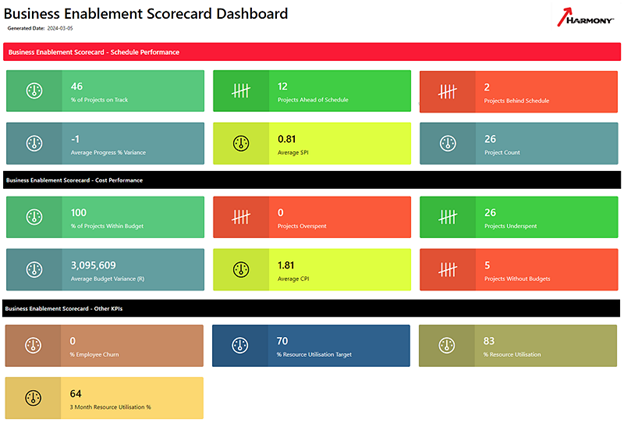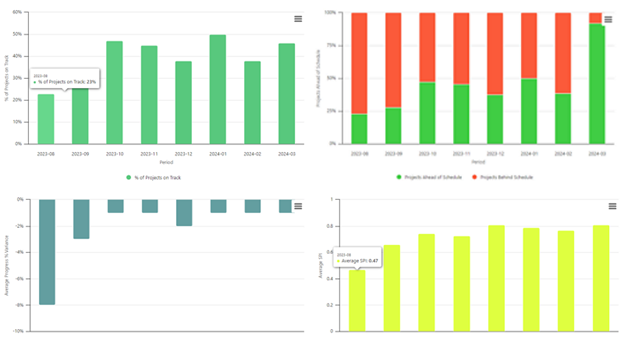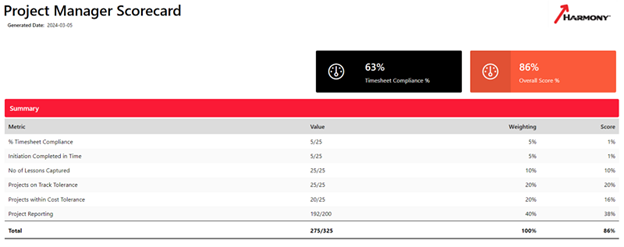Mining organisation tightens up performance management process, cuts information gathering time in half.
Project management offices (PMOs) often face the difficulty of having no real, objective way to measure the performance of their project managers. Harmony, an emerging market gold mining and exploration specialist with a sizeable copper footprint, is not alone in experiencing this challenge. However, this sustainable global mining company has succeeded in streamlining its performance management information gathering process, while also providing clearer direction for its project managers and administrators.
On joining Harmony’s PMO, Helga Olivier, the organisation’s PMO manager, discovered that it was taking an excessive amount of days for project completion, making delivery improvement one of her key focus areas.
“On average, depending on the project’s type, size and of course the methodology used, IT-related projects should ideally be completed in between 84 to 300 days, with some exceptions,” she explains. “It became a priority, then, for the Harmony PMO to find a better way to see project delivery statuses, identify project pain points and understand other influences on duration.”
At that point, says Olivier, the PMO was using a tedious, manual method to measure the performance of its project managers and administrators, which was ultimately also a more subjective and emotional process.
“Quite often, we found that information was very difficult to find and could even take the form of hand-written numbers. We wanted to digitalise and automate this paper-based procedure and manage it by exception, thus making it not only more efficient, but also more impartial,” she clarifies.
Harmony’s PMO had already been using Project Portfolio Office’s project and portfolio management solution, PPO, for several years, so it was a natural next step to see whether the tool could also be used to introduce a Project Manager Scorecard.
“The idea behind this was to provide a structured and visual way to communicate key performance indicators (KPIs) and performance expectations to PMO staff members and align individual project manager performance with overall PMO and organisational goals. Based on these requirements, we approached Project Portfolio Office to see whether they could assist us in achieving this, and what they brought to us really blew my mind.”
Aligning Project Manager KPIs with business objectives
“The first stage in this process for Harmony was to introduce PMO metrics that were aligned with the organisational objectives,” explains Guy Jelley, CEO and co-founder of Project Portfolio Office. “These KPIs included schedule and cost performance, resource capacity planning and utilisation, on-time completion, employee churn, and billable utilisation, amongst others.

“Once these objectives were accepted from key stakeholders, a business enablement scorecard was introduced in PPO to track the performance against these metrics. This is an automated output that is reviewed monthly and comprised of daily snapshots taken of the performance against these metrics.”
 The Project Manager Scorecard was then established to support the achievement of the PMO Scorecard, with the objective of creating an effective tool to cascade the PMO metrics throughout the project community. “The Project Manager Scorecard needed to enhance communication, accountability and overall project management effectiveness,” Jelley adds.
The Project Manager Scorecard was then established to support the achievement of the PMO Scorecard, with the objective of creating an effective tool to cascade the PMO metrics throughout the project community. “The Project Manager Scorecard needed to enhance communication, accountability and overall project management effectiveness,” Jelley adds.

Allowing for informed, unemotional performance discussions
According to Olivier, the Project Manager Scorecard was introduced to Harmony’s project managers, each with their own project administrators, in a phased approach, allowing the PMO team to slowly mature into the new process. “We’re now able to use the Project Manager Scorecard as the basis of our weekly meeting reports, providing us with a succinct, real-time overview of project statuses.
“With our focus on governance, this beautiful representation of our data has made it much easier to see where challenges lie, allowing the PMO team to have informed discussions around hold-ups. In addition, PPO has allowed the process of information collection for these discussions to be cut almost in half,” she continues.
“The benefit for our project managers is that they now have clearer direction and guidelines. We have a more consistent process in place, so that they know what they are being measured on, and can be provided with constructive feedback and coaching, as well as motivation and recognition. Furthermore, our project managers and administrators can now also self-measure, which has led to some serious competition between PMO team members. It has also brought about positive change for the greater PMO in terms of performance discussions, which is particularly important within the contracting world. Decisions can be made that are not based on a perception of the person, but rather on the actual work put in by the individual.”

The timesheet metric, introduced as part of the new process, greatly assists with the PMO’s electronic invoicing. “Historically we would receive a vendor’s invoice and, because a resource would be working across multiple projects, I would need to assign percentage allocations accordingly to these projects and their allocated cost centres. Previously this was managed using an Excel spreadsheet, which could be challenging if rates changed at certain times during a month, or resources needed to be on- or offboarded.
“We now have contract management in place using PPO, a great new enhancement, and in time we expect PPO’s integration with Harmony’s financial system to help streamline these invoice payments. It’s possible to monitor weekly whether the PMO employees are using the timesheet compliance, and cross-check what has been entered against projected hours. Once this data is in place, I can go back to the procurement team and seamlessly automate the invoicing process.
“The KPI dashboard has also been very valuable in that we’re now able to look at lessons learned and see how future projects can be improved on.”
Olivier’s advice for other PMOs considering the automation of project manager performance tracking is to look at how other project offices, like Harmony’s PMO, have managed to successfully achieve this. “Don’t reinvent the wheel,” she says. “Other organisations’ PMOs have done the legwork, gone through the pain points and managed to implement processes that actually work.
“For example, the first metric we introduced within Harmony’s PMO was ‘closure completed on time’ compliance. We ended up replacing this with the timesheet compliance, as it was more aligned to our requirements.”
Olivier also advises PMOs to be cognisant of resource allocations. “Check whether they are all correct and have the same number of hours allocated, as this could influence your KPI calculations.
“My experience with Project Portfolio Office has been nothing short of phenomenal. No request is too big, and the PPO team is always willing to assist, while remaining very accommodating and quick with suggestions,” she concludes.


